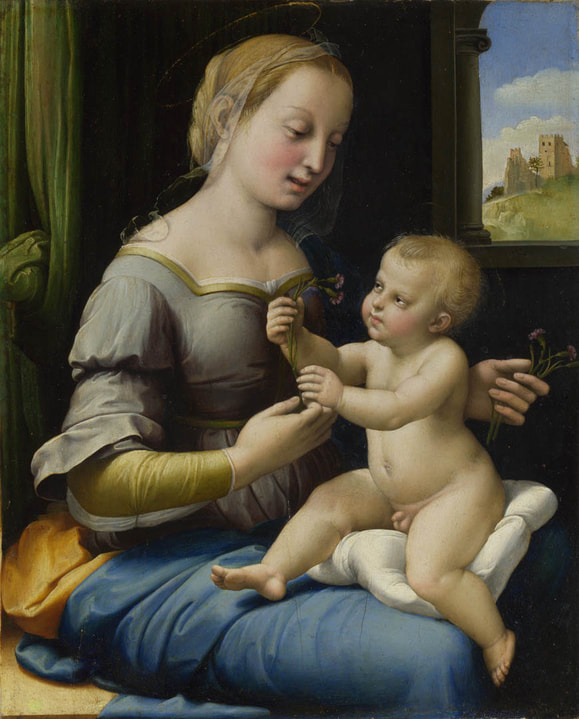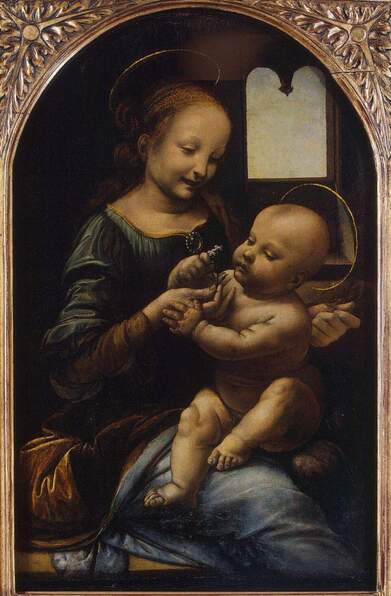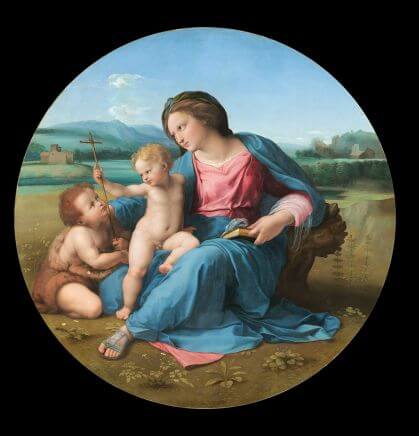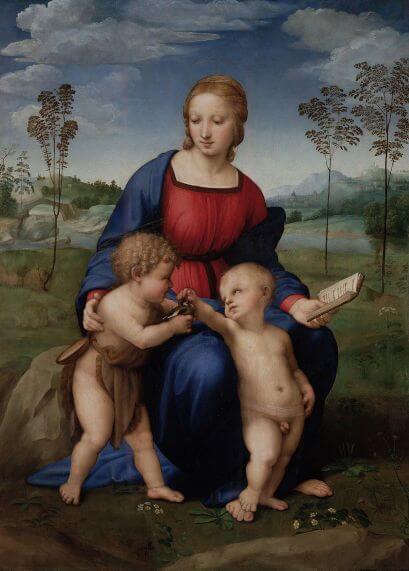|
Where? Room 60 of the National Gallery
When? 1506-1508 Commissioned by? Probably the Oddi family, a prominent family from Perugia. What do you see? The young Virgin Mary is sitting on a yellow-brown bench with Baby Jesus on her lap and you can see the faint halos above their heads. Mary looks at Jesus and is playing with him. She holds two flowers in her left hand and in her right hand she holds another flower which Baby Jesus is examining. The flowers are identified as pink carnations (also referred to as pinks). Jesus is sitting on top of a white cushion and is absorbed by the flower. Mary is wearing a greyish dress with a belt, and her dress is yellow-gold and white on the top and on her right arm. She also has a blue robe around her legs, and this robe also covers her left side including her shoulder (this is a bit more difficult to see as this blue has darkened a bit over time). She is also wearing a transparent veil in her hair that falls over her shoulders. On the top right, you can look through the window and observe the hills, a castle, and the blue skies. On the left, you can see a green bedcurtain. Note also the quality of Raphael’s work. He carefully combined light and shadow to paint the folds in Mary’s dress and the bodies of Mary and Jesus. His delicate depiction of the translucent veil is also of very high quality. Backstory: This painting is also referred to as La Madonna dei Garofani (which is Italian for ‘The Madonna of the Carnation’) or the Northumberland Madonna (after its previous owner). It is heavily inspired by the Benois Madonna painting by Leonardo da Vinci which can be admired in the Hermitage Museum in Saint Petersburg. The Madonna of the Pinks is a small painting (27.9 cm × 22.4 cm or 11.0 in × 8.8 in), and it may have been created for the nun Maddalena degli Oddi to bring with her wherever she went as an aid for prayer. There are many copies of this painting which are clearly not made by Raphael. However, in 1992, the Duke of Northumberland agreed that the version he owned would be displayed in the National Gallery and could be cleaned and investigated using infra-red reflectography. The investigation concluded that this painting was the original made by Raphael (though some experts still doubt this attribution nowadays). The painting is still in excellent condition, but some cracks can be seen. For example, in the bottom middle, there is a clear vertical crack that runs up through the right leg of Jesus and the back of Mary’s right hand.
Symbolism: The main symbol in this painting is the pink carnation (or pink). According to a legend, this flower first appeared on earth from the tears of Mary that fell on the cross at the crucifixion of Jesus. Pink carnations symbolize the divine love of Mary towards Baby Jesus. They are also seen as a symbol of divine protection and marriage. The pink carnation is still a popular flower for Mother’s Day in the U.S.
The scene of Mary and Jesus is situated in a bedchamber, which is a symbol of maternity. Furthermore, the castle towers seem ruined, which is a symbol of the demise of the pagan world after the birth of Jesus. Who is Raphael? Raffaello Sanzio da Urbino (1483-1520) was born in Urbino in Italy. Together with Leonardo da Vinci and Michelangelo, he is considered to be one of the three prime painters of his time. He moved to Florence in 1504 where he created this painting. During that time he primarily created Madonnas and portraits. In 1508 Raphael moved to Rome to work for the Pope. Raphael often included the Madonna theme in his paintings. For example, the Alba Madonna in the National Gallery of Art in Washington, DC shows Mary, Jesus, and Saint John. Another example is the Madonna of the Goldfinch in the Uffizi Museum in Florence, which also shows Mary, Jesus, and Saint John.
Fun fact: The painting was acquired by the National Gallery in 2004 for almost ₤35 million (which was equivalent to about $60 million at that time). Given its small size, this painting became the most expensive painting ever sold per square centimeter. The acquisition of this painting was not easy, however, as the National Gallery and the J. Paul Getty Museum in Los Angeles were fighting a public battle over this painting.
Both museums were willing to offer an equal amount of money for the painting. However, the National Gallery came up with some very favorable tax advantages for the seller, who was the Duke of Northumberland and thus lived in England. Interestingly, when the painting was discovered in the collection of the Duke in 1991, it was considered a copy of Raphael’s original painting that was missing and only valued at ₤6000.
Written by Eelco Kappe
References:
0 Comments
Leave a Reply. |
Categories
All
|
- Home
- Blog
-
Museums
- Alte Pinakothek
- Art Institute of Chicago
- Baltimore Museum of Art
- Barber Institute of Fine Arts
- Bargello
- Barnes Foundation
- British Museum
- Church of Sant’Anastasia
- Cleveland Museum of Art
- Courtauld Institute of Art
- Detroit Institute of Arts
- Frans Hals Museum
- Galleria Borghese
- Gallerie dell'Accademia
- Getty Museum
- Guggenheim
- Hermitage Museum
- Kunsthistorisches Museum
- Kunstmuseum Basel
- Legion of Honor Museum
- Louvre
- Mauritshuis
- Metropolitan Museum of Art
- Musee d’Orsay
- Museum of Fine Arts in Boston
- Museum of Modern Art
- National Gallery in London
- National Gallery of Art
- National Museum in Poznań
- Norton Simon Museum
- Ny Carlsberg Glyptotek
- Palace of Versailles
- Palazzo Pitti
- Palazzo Vecchio
- Petit Palais
- Philadelphia Museum of Art
- Prado
- Pushkin Museum
- Ravenna Art Museum
- Rijksmuseum
- San Diego Museum of Art
- Santa Maria delle Grazie
- St. Peter's Basilica
- Städel Museum
- Statens Museum for Kunst
- Tate Britain
- Tate Modern
- Timken Museum of Art
- Uffizi
- Vatican Museums
- Wallace Collection
-
Artists
- Altdorfer
- Anguissola
- Berlin Painter
- Bosch
- Botticelli
- Boucher
- Bronzino
- Bruegel the Elder
- Brunelleschi
- Cabanel
- Caillebotte
- Canova
- Caravaggio
- Carpeaux
- Cezanne
- Cimabue
- David
- Degas
- Delacroix
- De Maria
- Donatello
- El Greco
- Fontana
- Fra Angelico
- Fragonard
- Gauguin
- Gentileschi
- Gericault
- Gonzalez-Torres
- Goya
- Hals
- Hogarth
- Hokusai
- Ingres
- Leonardo da Vinci
- Lippi, Filippo
- Longhi, Barbara
- Lorrain
- Makovsky
- Manet
- Massys
- Matisse
- Merian
- Michelangelo
- Mochi
- Modigliani
- Monet
- Panini
- Parmigianino
- Perugino
- Picasso
- Pisanello
- Raphael
- Rembrandt
- Renoir
- Reynolds
- Rivera
- Rodin
- Rubens
- Scultori
- Seurat
- Steen
- Tintoretto
- Titian
- Toulouse-Lautrec
- Turner
- Uccello
- Van der Weyden
- Van Dyck
- Van Eyck
- Van Gogh
- Van Hemessen
- Vasari
- Velazquez
- Vermeer
- Veronese
- Vigée Le Brun
-
Locations
- Books
- About Us




